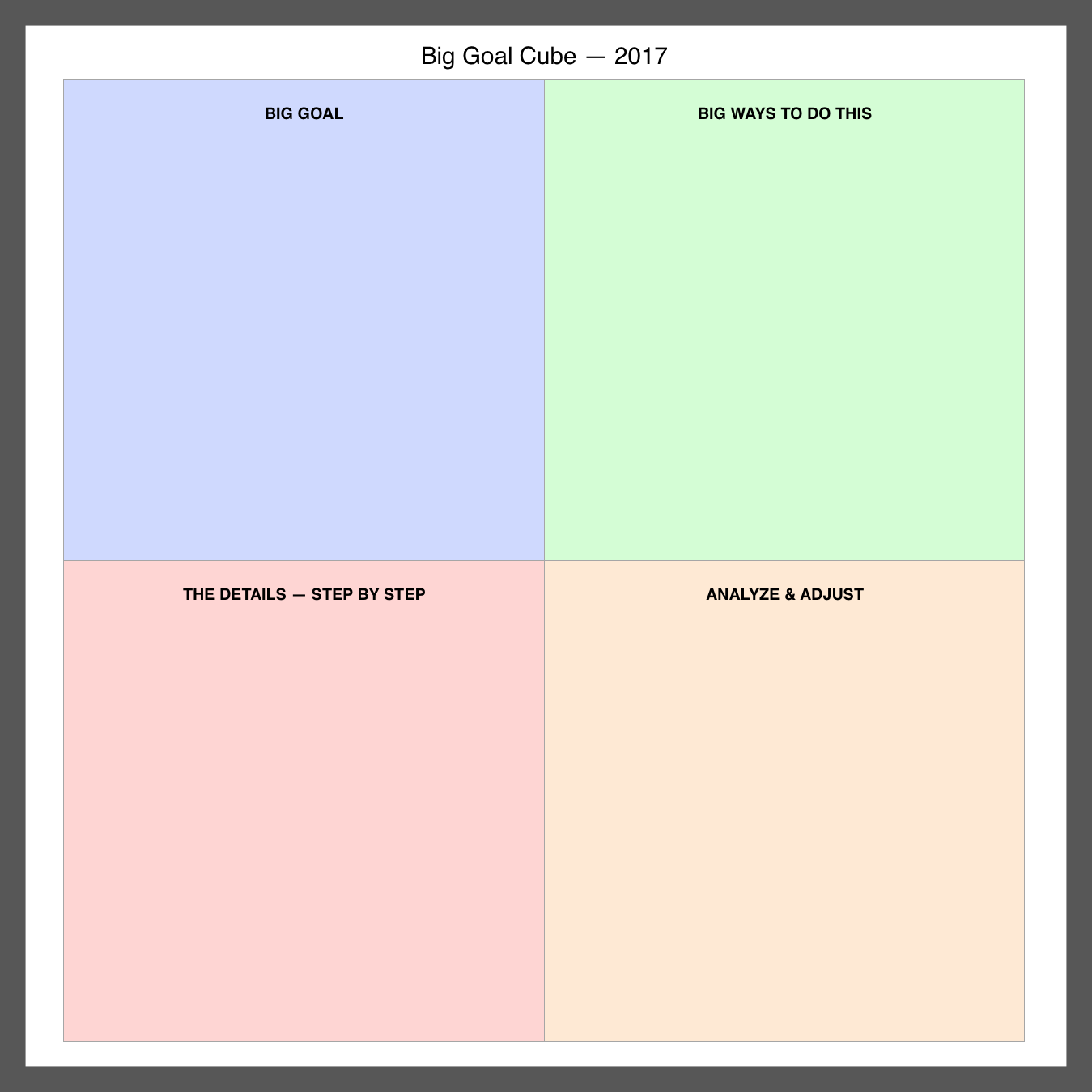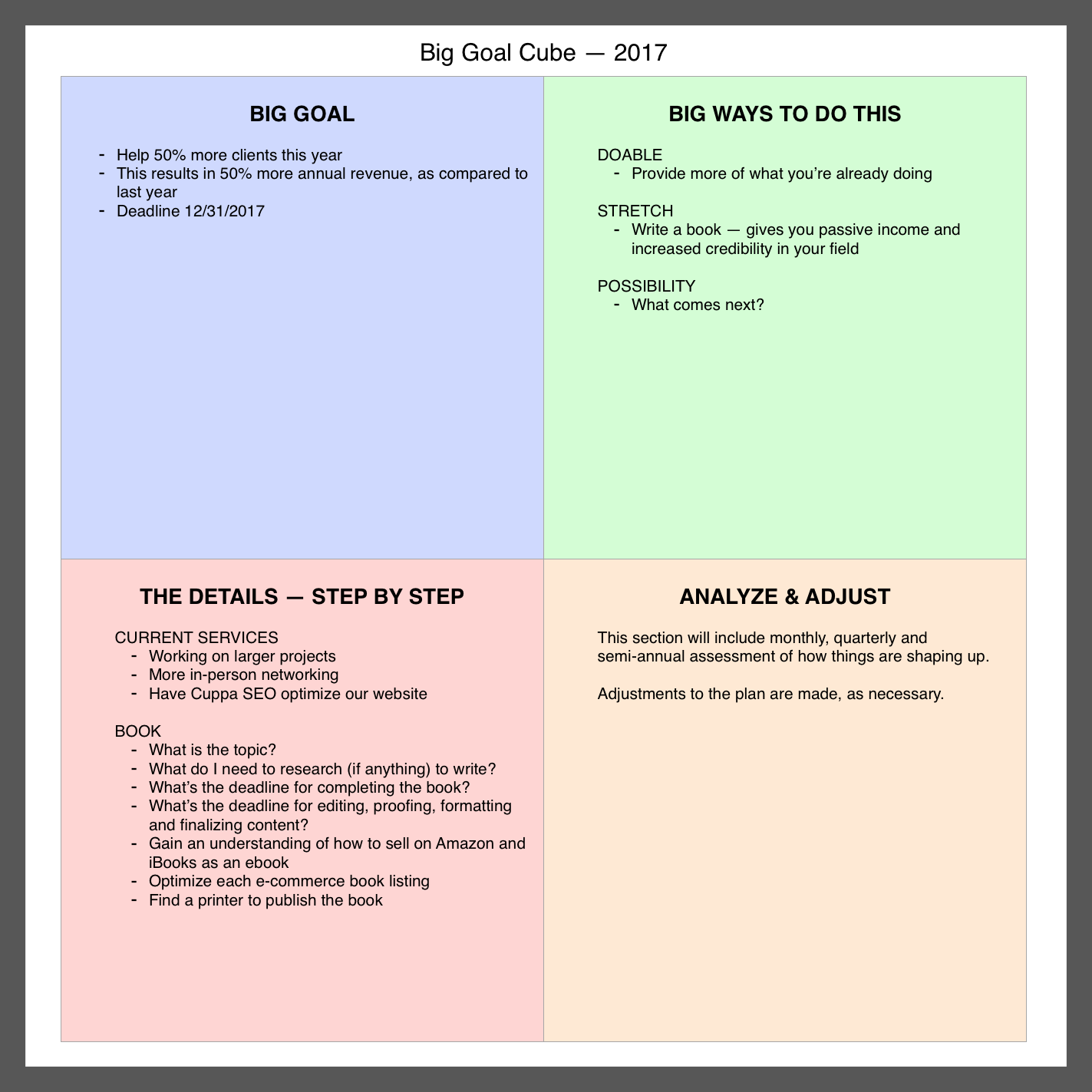 As we roll into the new year, it’s quite possible you’ve started thinking about what you’d like to accomplish over the next 12-months. I know that’s been the case for me — both personally and professionally.
As we roll into the new year, it’s quite possible you’ve started thinking about what you’d like to accomplish over the next 12-months. I know that’s been the case for me — both personally and professionally.
This year, while reading an excellent little book called The One Thing, by Keller and Papasan, I came across a tool the authors call “The Great Question Matrix.”
Essentially it’s a four-quadrant grid that helps you define a specific goal in four ways …
- Small & broad
- Small & specific
- Big and broad
- Big and specific
And although I liked the concept, it didn’t really resonate with me to put too much attention on a small goal. This is because the authors basically defined the small goal as, well, small and easy to accomplish — the type of goal that was not life changing or transforming. In other words a small goal is safe, and in some ways inconsequential.
The big goal sections caught my attention though, so I decided to transform The Great Question Matrix into something that was more meaningful to me: The Big Goal Cube.
I like the Big Goal Cube so much, I wanted to share it here, so others could benefit from it, too. I’ve included some examples in each of the four quadrants of the cube so you can understand how to use it…
Big Goal
This first quadrant is for the “global view” of your big goal. And although it’s got to be a specific goal — like “help 50% more clients this year” — it doesn’t contain a lot of detail. That said, be sure to have an actual date for your deadline.
Often times, organizations choose a financial goal like, “double our revenue,” or “increase sales by 50%” as a goal. A word of caution on this. Revenue is the byproduct of accomplishing something else, not the goal in-and-of itself.
In other words, if you’re a clothing company, a goal of increasing sales by 50% is only a monetary goal (obviously). It’s the result of selling more clothes, right? But why did you start your clothing company to begin with? To be the latest trend-setting designer? To offer affordable, well-made and stylish clothing to the middle class? To make ski boots so rugged, and so comfortable, that they are the number one choice for every ski enthusiast?
What I’m driving at here is what makes your business tick — what’s at the heart of it that convinced you to start the company or work for it in the first place? For some, the answer will be money, but for most there will be something more.
Big Ways to Do This
Here’s where we get a little more specific about the goal. Once again inspired buy the book, The One Thing, I’ve broken down this section into three categories:
- Doable: which is essentially doing more of what you’re already doing. This is the easiest of the three categories to achieve.
- Stretch: In the above example, writing a book is your stretch goal. It’s not something you’ve done before, and you don’t have all the answers. As defined in The One Thing, “While this is still within you reach, it can be at the farthest end of your range … Think of this as potentially achievable and probable, depending on your effort.”
- Possibility: What’s next? As Keller and Papasan put it, “a possibility answer exists beyond what is already known and being done. This type of answer is hardest to come by.” But when you extend yourself to find this answer, you “expand and enrich your life for the better.” Finding this answer will require research, brainstorming and very likely a mastermind group of peers and a coach.
The Details — Step by Step
Here’s where we really dig in and define the “bite-sized” steps we need to take in order to accomplish the big goal we’ve laid out in the first two quadrants. As you can see, I’ve broken this down to mirror the “doable” and “stretch” categories, so there are specific actions you can take for each. Of course, this is only an example, and your actual quadrants may involve more or less steps.
Analyze and Adjust
Decide, in advance, when you’re going to check in with how the goal is coming along. I suggest monthly, quarterly and semi-annually. The more your goal is top of mind, and the better you understand where you’re at, the greater your chances of success.
Knowing exactly where you’re at also gives you the opportunity to adjust, as necessary. And remember, adjusting does NOT indicate that you’ve failed at something. It just indicates you need to change course to get where you want to go.
If you’d like to work on your own goal cube to help with your 2017 goals, feel free to download the file as a Numbers or Excel doc.
Thanks for visiting, and best of luck with your big goal!
Related Articles
- Running a Small Business & the Art of Balance
- Running a Small Business & the Art of Discovering Goals
- Running a Small Business & the Art of Defining Goals
- Running a Small Business & the Art of Setting Goals
- Running a Small Business & the Art of Overcoming Obstacles
- Running a Small Business & the Art of Setting a Date on Your Goals
- Creating an Action Board (Vision Board)

